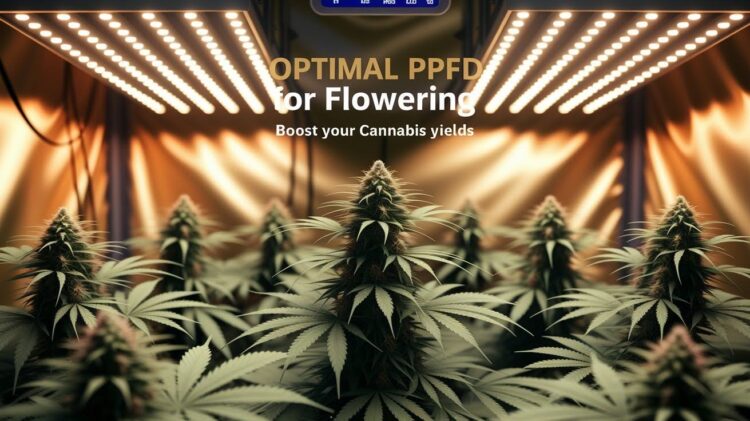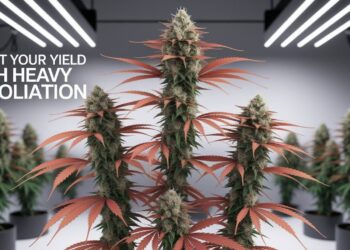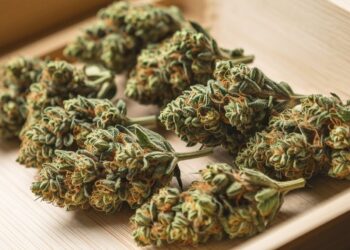Getting the right light intensity during flowering can make or break your harvest. I learned this the hard way after years of mediocre yields and wondering why my buds weren’t dense enough.
PPFD stands for Photosynthetic Photon Flux Density. It measures exactly how much usable light hits your plants every second. Think of it as your plant’s food delivery system.
After testing different PPFD levels across dozens of grows, I’ve seen yields increase by 40% just from getting the numbers right. This guide will teach you the exact PPFD ranges that work.
You’ll learn what PPFD means in simple terms. We’ll cover why flowering plants need more intense light than vegetative plants. I’ll share the specific numbers that consistently produce dense, resinous buds.
By the end, you’ll know exactly how much light your flowering plants need. No more guessing or wasted electricity on ineffective lighting setups.
All information is for legal cultivation only.
Understanding PPFD Fundamentals
PPFD measures the actual photons plants use for photosynthesis, making it the only light measurement that truly matters for cannabis growth, unlike watts or lumens, which don’t indicate plant-usable light.
1. PPFD vs Other Light Measurements
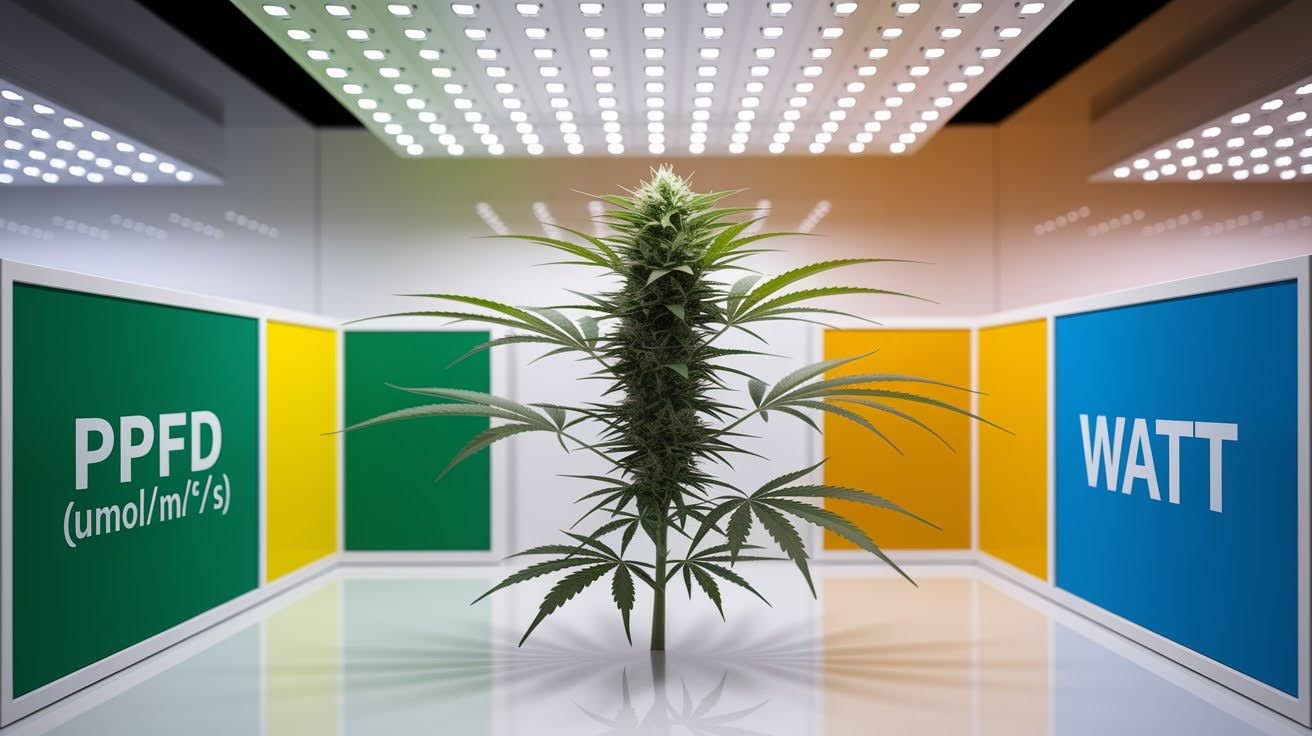
Most growers get confused by all the light terms. I spent my first year mixing up watts, lumens, and PPFD. Big mistake.
PPFD is the only measurement that matters for plant growth. Watts tell you electricity you use. Lumens measure what humans see. Neither helps your plants.
Here’s why PPFD wins every time:
PPFD measures photons that plants use for photosynthesis. It’s measured in micromoles per square meter per second. Think of it as counting food particles hitting your plant’s leaves.
But PPFD isn’t the whole story. You also need to understand DLI.
DLI stands for Daily Light Integral. It’s like adding up all the PPFD your plant gets in 24 hours. High PPFD for 12 hours might equal lower PPFD for 18 hours.
PAR is another term you’ll hear. Photosynthetically Active Radiation covers light from 400 to 700 nanometers. This is the range plants use most efficiently.
Quality matters as much as quantity. Red light drives flowering. Blue light supports structure. A balanced spectrum at the right PPFD beats intense light in the wrong colors.
I learned this after buying cheap blue LEDs that measured high PPFD but grew terrible buds.
2. Essential Equipment for PPFD Measurement
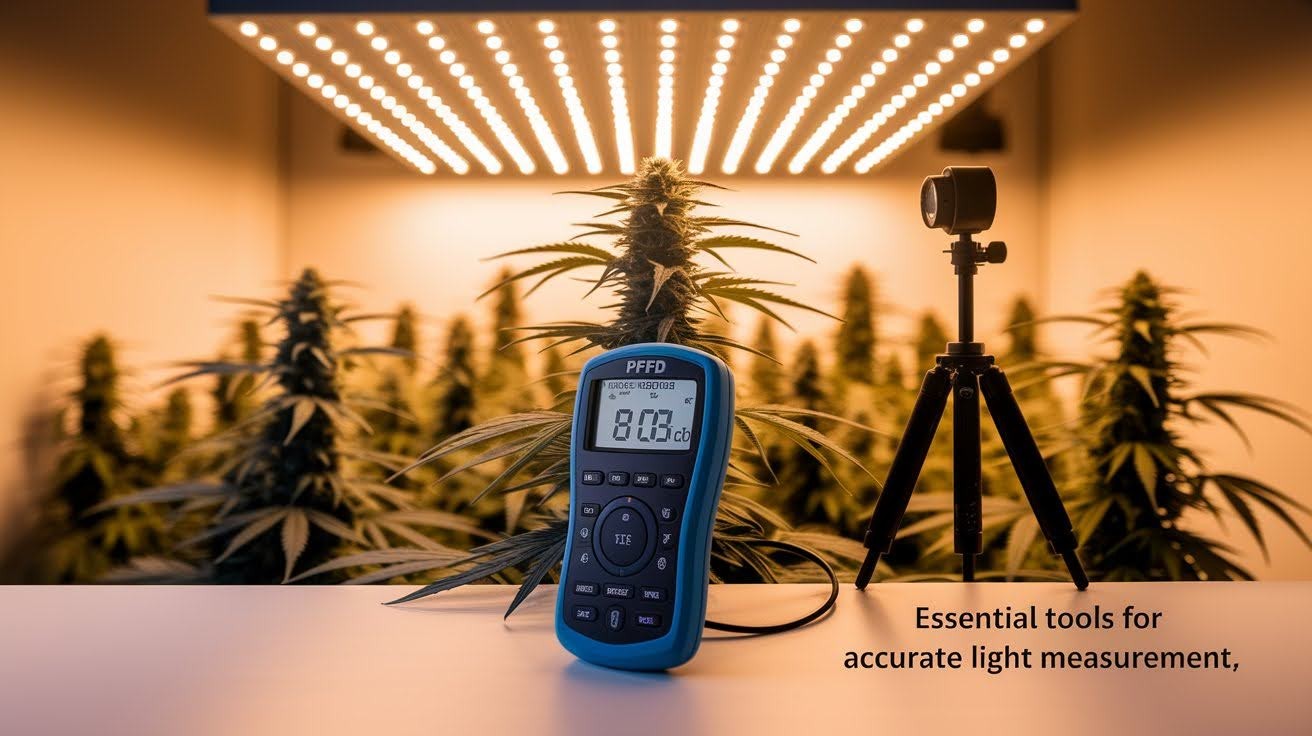
You can’t manage what you can’t measure. I used to guess light levels by looking at my plants. That’s like cooking without a thermometer.
A PPFD meter is your most important tool. Don’t buy the cheapest one online. Quality meters cost $200 to $500. Yes, it’s expensive. But one good harvest pays for itself.
Always take readings at canopy level. This means holding the sensor where your buds are growing. Not above the lights.
Never rely on just one measurement. Light distribution varies across your grow space. Take readings in at least five spots.
Check the center first. Then measure each corner. Hot spots and dead zones will surprise you.
Move lights based on these readings.
Optimal PPFD Ranges for Each Growth Stage
Each growth stage requires specific light intensity (PPFD), with lower levels for seedlings and clones, and higher levels for vegetative and flowering stages, particularly when using CO2 for optimal yields.
1. Complete Growth Stage PPFD Chart

Every growth stage needs a different light intensity. I used to blast seedlings with flowering-level PPFD. They hated it.
Here are the exact numbers I use for each stage:
Seeds need gentle light at 200-300 μmol/m²/s. Think of them like newborn babies. Too much light burns their tiny leaves.
Clones get even less at 100-125 μmol/m²/s. They’re focusing on growing roots, not leaves. Highlight stresses them during this critical time.
Seedlings can handle 100-300 μmol/m²/s as they develop their first real leaves.
Vegetative stages ramp up the intensity. Early vegetative plants thrive at 200-400 μmol/m²/s. They’re building their structure and leaf mass.
Late vegetative plants want 450-600 μmol/m²/s. This prepares them for the flowering demands ahead.
Mother plants also stay at 450-600 μmol/m²/s. They need consistent, moderate light to produce healthy clones.
Flowering is where things get serious. Early flower jumps to 700-800 μmol/m²/s. Your plants are switching gears from growth to bud production.
Full flower depends on your setup. With CO2, you can push 1200-1500 μmol/m²/s. Without CO2, it stays between 600-900 μmol/m²/s maximum.
Going higher without CO2 causes light stress and burns.
PPFD Requirements for Flowering Stage
Gradually increase PPFD by 10-20% when transitioning to flowering (600-700 μmol/m²/s) to avoid shocking plants with sudden light intensity changes.
1. Early Flowering PPFD Needs
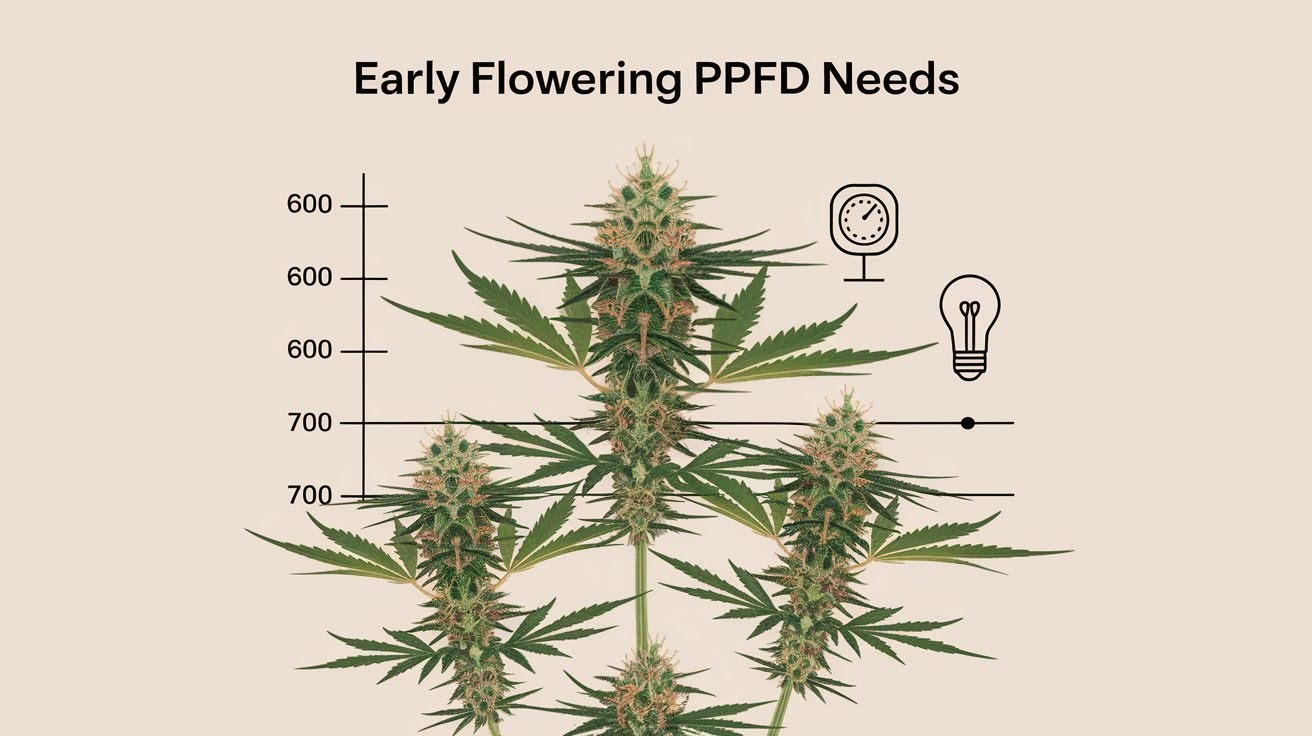
The transition to flowering is critical for your plants. I used to jump straight from 500 to 900 μmol/m²/s overnight. Big shock to the system.
Start early flowering at 600-700 μmol/m²/s. This gives your plants time to adjust to higher light intensity while they’re switching to bud production mode.
Don’t make dramatic jumps in PPFD. Your plants were comfortable at vegetative levels around 450-600 μmol/m²/s. A gradual increase prevents stress.
Aim for a 10-20% boost from your vegetative stage levels. If you were running 500 μmol/m²/s in late veg, bump up to 550-600 μmol/m²/s for early flower.
I learned this lesson after watching my plants curl their leaves and show stress signs from sudden light increases.
Watch your plants closely during this transition. Look for leaf curling, bleaching, or brown spots. These are warning signs of light stress.
Healthy plants will show no stress signs. Leaves stay flat and green. New growth looks vigorous. Internodes start tightening up as flower sites develop.
If you see stress, back off the intensity immediately. Better to go slow than to be sorry.
2. Peak Flowering PPFD Requirements
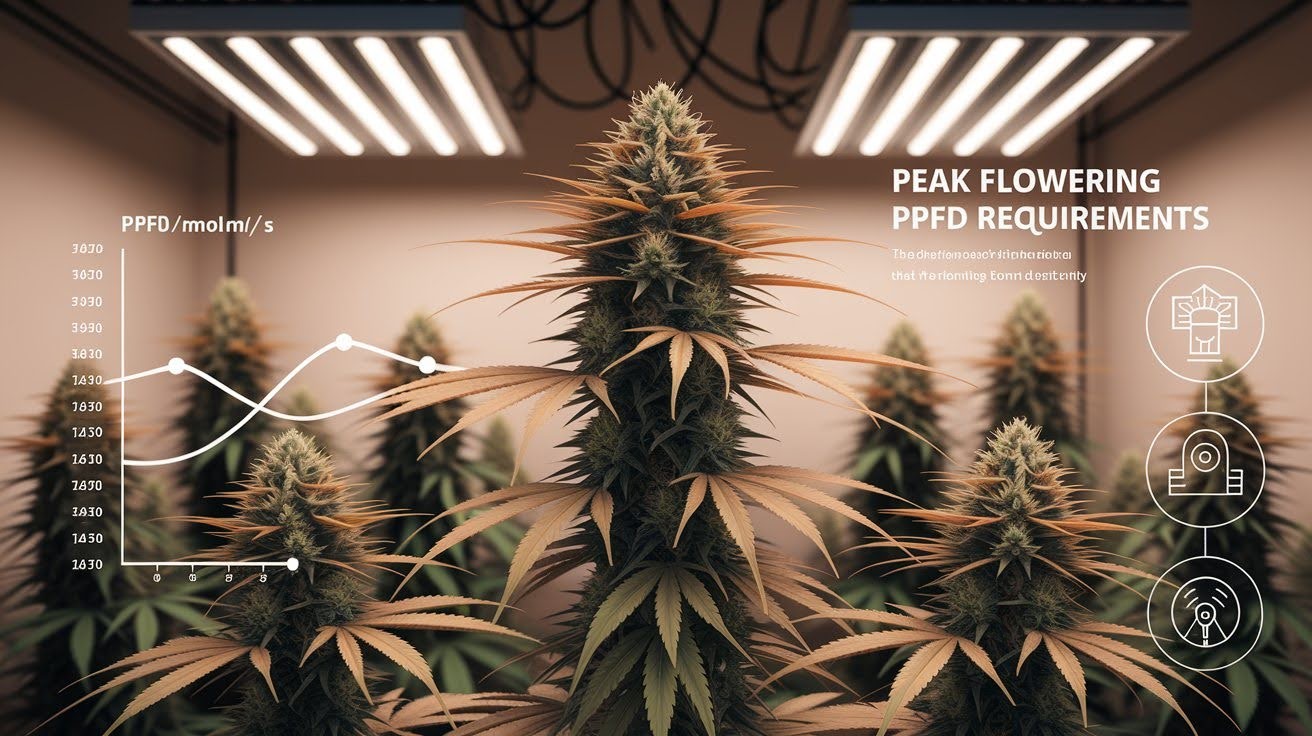
Peak flowering is where the magic happens. This is when your plants pack on serious weight and resin. Get the PPFD wrong here and you’ll regret it at harvest.
Without CO2, stick to 700-900 μmol/m²/s maximum. I’ve pushed higher and watched my plants burn. The leaves bleach white and curl up like potato chips.
With CO2 supplementation, you can run 1200-1500 μmol/m²/s. But this requires a sealed room and proper environmental control. Most home growers can’t do this effectively.
Here’s what researchers found that blew my mind. Studies showed linear yield increases all the way up to 1800 μmol/m²/s. That’s incredibly high intensity.
But there’s a catch. You need perfect environmental control at those levels. Temperature, humidity, CO2, and nutrients must be dialed in precisely.
Commercial growers can handle these extreme levels. They have automated systems and full-time staff monitoring everything.
Hobbyist growers should stay conservative. I run 800 μmol/m²/s in peak flower without CO2. My yields are excellent, and my plants stay healthy.
Remember this simple rule. It’s better to have healthy plants at 800 μmol/m²/s than stressed plants at 1200 μmol/m²/s.
3. Late Flowering Adjustments
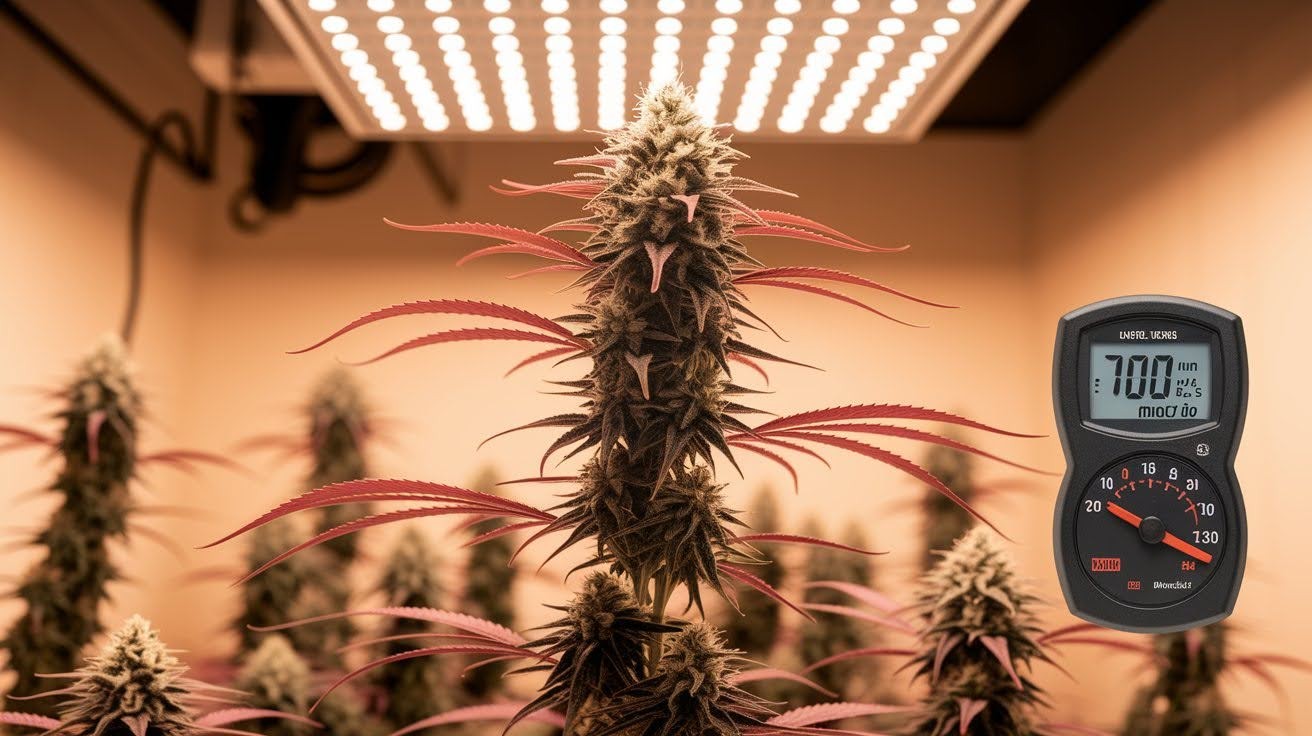
The final weeks of flowering test your PPFD skills. I used to think plants needed less light as they finish growing. Wrong assumption.
Maintain high PPFD levels right through harvest. Your buds are still swelling and producing resin during these crucial final weeks. Dropping intensity now costs you yield.
But watch your plants like a hawk. Late-flowering plants become more sensitive to light stress. Those beautiful sugar leaves can bleach quickly under excessive intensity.
Look for these warning signs:
Upper leaves are turning white or yellow. Leaf edges curling upward. Brown spots are appearing on fan leaves.
Here’s what healthy late flowering looks like. Leaves stay green except for natural fading. Trichomes develop properly without burning. Buds continue swelling.
Final maturation needs consistent light. Your plants are putting finishing touches on cannabinoid and terpene production. Inconsistent PPFD disrupts this delicate process.
I learned this after reducing light intensity in week 8 and getting lower potency results.
Avoid the temptation to blast them harder. Some growers think more light equals better buds in the final stretch. This usually backfires with a light burn.
Keep your proven PPFD levels steady. Let your plants finish naturally under optimal conditions.
Conclusion
Getting PPFD for flowering right is simpler than most growers think. Start at 600-700 μmol/m²/s for early flower, then work up to 700-900 μmol/m²/s for peak production. Stay within these ranges without CO2, and your plants will reward you with dense, resinous buds.
Your light intensity problems are solved. No more guessing or wasted electricity. You now have the exact numbers that consistently produce better yields.
Remember to measure at canopy level and watch for stress signs. Gradual increases beat dramatic jumps every time.
Got questions about your specific PPFD for flowering setup? Drop a comment below. I love helping fellow growers dial in their lighting for maximum results.
Happy growing, and may your buds be dense and frosty!
Always grow within your local laws.
Frequently Asked Questions
What is the optimal PPFD for flowering cannabis without CO2?
The optimal PPFD for flowering without CO2 is 700-900 μmol/m²/s. Start at 600-700 μmol/m²/s for early flower, then gradually increase to 800-900 μmol/m²/s for peak flowering. Going higher without CO2 supplementation causes light stress and leaf burn.
Can I use higher PPFD for flowering with CO2 supplementation?
Yes, with proper CO2 supplementation, you can run 1200-1500 μmol/m²/s during flowering. This requires a sealed grow room, consistent CO2 levels, and precise environmental control. Most home growers should stick to the 700-900 μmol/m²/s range without CO2.
How do I gradually increase PPFD when transitioning to flowering?
Increase PPFD by 10-20% from your vegetative levels when switching to flowering. If running 500 μmol/m²/s in late veg, start flowering at 550-600 μmol/m²/s. Then gradually increase by 25 μmol/m²/s daily until reaching your target flowering PPFD.
What are the signs of too much PPFD during flowering?
Signs of excessive PPFD include leaf bleaching (turning white), upward leaf curling, brown spots on leaves, and stunted growth. If you notice these symptoms, immediately reduce light intensity. Healthy flowering plants show flat, green leaves with vigorous bud development.
Should I maintain the same PPFD throughout the entire flowering stage?
No, adjust PPFD progressively during flowering. Start at 600-700 μmol/m²/s for early flower, increase to 800-900 μmol/m²/s for peak flowering, then maintain high levels through harvest. Monitor plants closely for stress signs and adjust accordingly.

